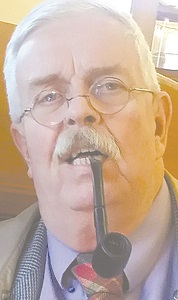
Remember timelines we had to make in elementary school history classes? We drew a horizontal line, then vertical dashes to mark im-portant dates.
For example, in February we might mark the 12th as Lincoln’s birthday, Washing-ton’s birthday 10 days later. If we had a good teacher, we would fill in a few other days with people and events.
No doubt other things hap-pened on other days that month, but we hit at least two high points. Valentine’s wasn’t history so didn’t count.
No matter how big and long the line might have enough space to mark every-thing that happened just in this country in just one month. There is even less space and time to mark eve-rything that happened throughout the world.
Defined dates are an objec-tive part of history. The other part is subjective, say our understanding and interpre-tations of Lincoln, Washing-ton or a James Joyce nov-el. It gets even more subjec-tive when we weigh the influ-ence of Sylvia Beach, Ger-trude Stein or even Picasso on Joyce, and the author’s influence on others. That side requires critical thinking and logical debate.
A few years back I came across three books about the Minnesota Third Militia campaign during the 1862 Sioux uprising. It was strictly objective: names, dates, miles traveled on each day and so on. I learned foods they carried, ammuni-tion used and so on. On the whole it was dry, dry, dry.
A little later I came across a collection of oral history and memoirs about the same events, told by the settlers who were there, but not writ-ten down until the 1890s. That was subjective because the same stories were sometimes very differ-ent. Interestingly, both sets of books were published by the Minnesota State Histori-cal Society.
Therein is the challenge of history. For several hundred years everyone more or less agreed Edward Gibbons’s “Decline and Fall of the Ro-man Empire was the defini-tive word on the subject.
Then came Professor Mary Beard of Cambridge who used the same names and dates but developed differ-ent theories. The debate over who was right or wrong has kept historians off the un-employment line for years.
Critical Race Theory has become a hot-button topic. The New York Times’ 1619 Project basically said, “He, listen up. You have forgotten about and excluded us.”
It explored the history of U.S., slavery, abuses against blacks and, at the same time, their contributions to the growth and development of our land. It is one thing to breeze too quickly through a historical topic, to neglect it entirely is atrocious. From the opening bell, critical race theory has been divisive.
Many Turks 100 years ago despised Christian Armeni-ans and created the 20th century’s first genocide. Mil-lions of Armenians died as a consequence. Even today the Turkish government op-poses anyone, journalists especially, who bring up the subject.
Then again, there is so much history we can’t cover everything.
If I spend time reading about the Minnesota Third Militia and oral histories col-lected in “The Fencepost Tales,” I have less time to look at what else happened during the Civil War.
I can read about Minneso-ta, but by default left out Iowa, Wisconsin and the Dakota territories … What about economic, transporta-tion, agricultural, medical and/or non-military technol-ogy then?
I like Paul Whiteman’s 1920s music, but if I spend leisure time listening to it, I am probably neglecting other types of music from the same era. No one can do it all.
Neither can our schools teach everything, especially given history is just one sub-ject. Perhaps the best we can do is inspire students to see how much fun they can have exploring their history and weaving it into their own stories. That will keep them studying for decades.
